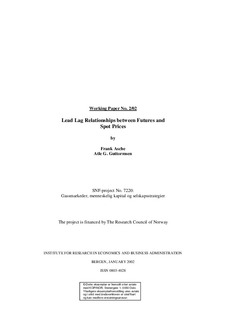| dc.description.abstract | In this paper we examine the relationship between spot and futures prices. This is traditionally done by testing for cointegration with the Engle and Granger methodology, before one specifes an error correction models in order to draw inference about causality. This approach, although appealing for its simplicity, is problematic on at least two accounts. First, the approach is only valid given an exogeneity assumption, which is what one wants to test, and second, given that there are several contracts with different times to expiration, bivariate specifications cannot capture all the relevant information. We show that both problems can be avoided if the tests are carried out in a multivariate framework like the Johansen test. An empirical application is carried out on futures prices for gas oil. Findings indicate that futures prices leads spot prices, and that futures contracts with longer time to expiration leads contracts with shorter time to expiration. | en |
